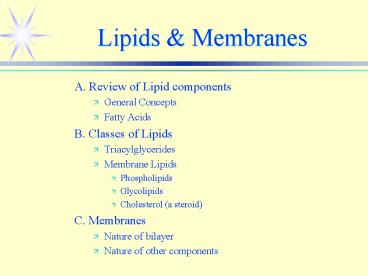Lipids - PowerPoint PPT Presentation
1 / 25
Title:
Lipids
Description:
extensive regions of hydrocarbon with only small proportion of polar groups ... 18 oleic CH3(CH2)7CH=CH(CH2)7COOH. 18 linoleic CH3(CH2)4CH=CHCH2CH=CH(CH2)7COOH ... – PowerPoint PPT presentation
Number of Views:194
Avg rating:3.0/5.0
Title: Lipids
1
Lipids Membranes
- A. Review of Lipid components
- General Concepts
- Fatty Acids
- B. Classes of Lipids
- Triacylglycerides
- Membrane Lipids
- Phospholipids
- Glycolipids
- Cholesterol (a steroid)
- C. Membranes
- Nature of bilayer
- Nature of other components
2
Lipid Functions
- compartmentalization with communication
- membranes
- energy storage
- fats and oils triacylglycerides
- permeability barriers
- suberin, cutin, waxes
3
Biological Lipids - Properties
- highly insoluble in water
- extensive regions of hydrocarbon with only small
proportion of polar groups - amphipathic
- regions compatible with water and with
biological hexane - formation of micelles, membranes and vesicles
- most lipids contain fatty acids
4
Fatty Acids - rules (review)
- Fatty Acid A long chain carboxylic acid having
an even number of carbon atoms. - unbranched
- 12 carbon chain length or longer
- if unsaturated, double bond is cis
- most common have 18 or 16 carbon atoms
5
Common Fatty Acids - Review
- Saturated
- 12 lauric CH3(CH2)10COOH
- 14 myristic CH3(CH2)12COOH
- 16 palmitic acid CH3(CH2)14COOH
- 18 stearic acid CH3(CH2)16COOH
- Unsaturated
- 16 palmitoleic CH3(CH2)5CHCH(CH2)7COOH
- 18 oleic CH3(CH2)7CHCH(CH2)7COOH
- 18 linoleic CH3(CH2)4CHCHCH2CHCH(CH2)7COOH
- 18 linolenic CH3CH2CHCHCH2CHCHCH2CHCH(CH2)7
COOH
6
Melting Points of Fatty Acids
- Saturated fatty acids in lipid materials stack
better than unsaturated fatty acids in these
materials - better stacking more van der Waals attractions
higher total attractions more heat needed to
break apart attractions higher melting points - Saturated fatty acids have higher melting points
than same size unsaturated fatty acids
7
Shapes of Fatty Acids
8
Components of Membranes
9
Phospholipids
- Common to all phospholipids
- fatty acid
- phosphate
- polar/ionic alcohol
- Additional components
- Unique to phosphoglycerides
- glycerol
- another fatty acid
- Unique to sphingomyelins
- sphingosine
10
Phosphoglycerides (review)
- Phosphoglycerides - Diglycerides that are also
phosphate esters of glycerol
11
Phosphoglyceride domains
12
Sphingomyelins
sphingosine
a sphingomyelin
always choline here
fatty acid attached here
phosphate
13
Spingomyelin Domains
- Polar head group
- Doubly charged
- Nonpolar tails
- Two hydrocarbon chains
- Same as with phosphoglycerides
- One chain is sphingosine
- Other is fatty acid
14
Glycolipids
A glycolipid is like a sphingomyelin except that
the phosphate is replaced by a sugar unit or a
combination of sugar units
sphingosine
sugar unit
fatty acid
15
Steroids and Cholesterol
16
Properties of membranes
- impermeable to polar molecules and ions
- highly flexible
- highly durable
- contain certain mix of lipids
- contain protein that have a purpose
- in more complex cells, contain carbohydrates
- are asymmetric with respect to chemical
composition and function
17
Membrane Locations
- External membranes
- Cell membrane
- Internal membranes
- Nucleus
- organelles
18
Membrane Fluidity
- Tm melting transition temperature
- ordinary melting point is the temperature at
which the liquid and solid phase are a
equilibrium - for lipid bilayers Tm is the temperature at
which half the component lipids in the bilayer
are in the "crystalline" state and the other half
are in the melted state - ordered state is nonmobile
- disordered state is mobile
19
Effect of Lipid Content on Tm
- short chain and/or unsaturated fatty acids in
lipids produce more "liquidy,oily (fluid)
materials - long chain saturated fatty acids give more rigid,
solid materials - membrane fluidity is highly influenced by
proportion of different fatty acids - effect of cholesterol dampen transition gives
membrane more of a dynamic range
20
Protein Composition
- integral proteins
- portion of protein is embedded in bilayer
- can be small or large portion
- sections of proteins that are compatible with the
nonpolar matrix of lipid bilayer nonpolar amino
acid side chains - peripheral proteins
- protein that is attached to an integral protein
not the lipid bilayer
21
Domains of Integral Protein
- Portion buried in membrane
- Nonpolar residues
- Residues favoring a helix
- Portion outside membrane
- Polar and charged
- Variable secondary, tertiary structure
22
Carbohydrates
- single units or chains can be attached
- important in recognition of cell types
- antigenic responses
- immunity
- intercellular signaling
23
Membrane Asymmetry
- lipids
- phosphatidylcholine and sphingomyelin face out
- charge on cholines
- phosphatidylethanolamine and phosphatidylserine
face in - neutral and - charge
- carbohydrates
- almost exclusively on outside face
- proteins
- receptors and transport
- characteristics differences based on role
24
Fluid mosaic model
25
Another membrane model































